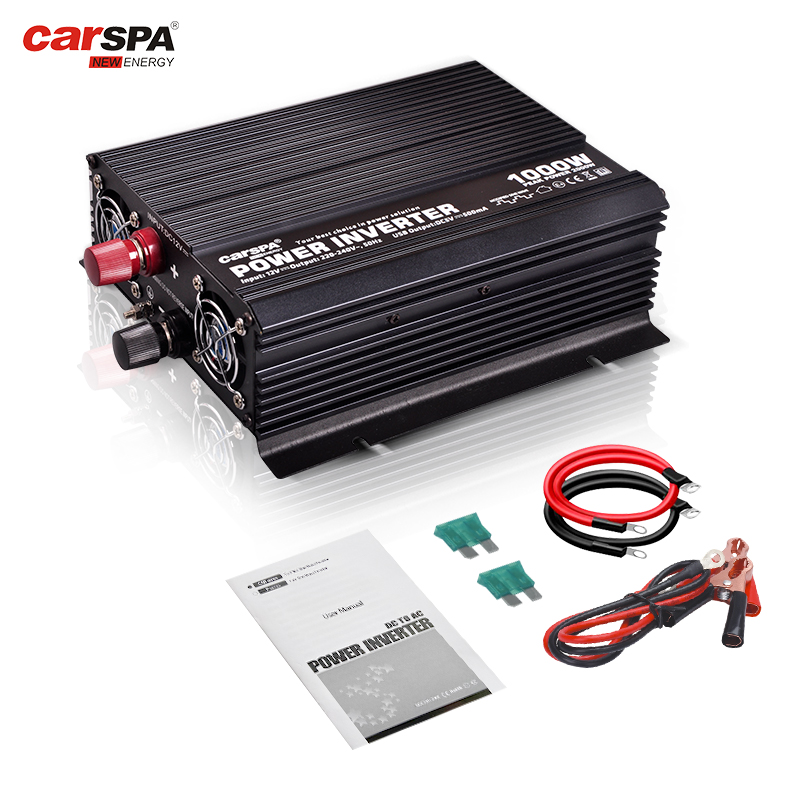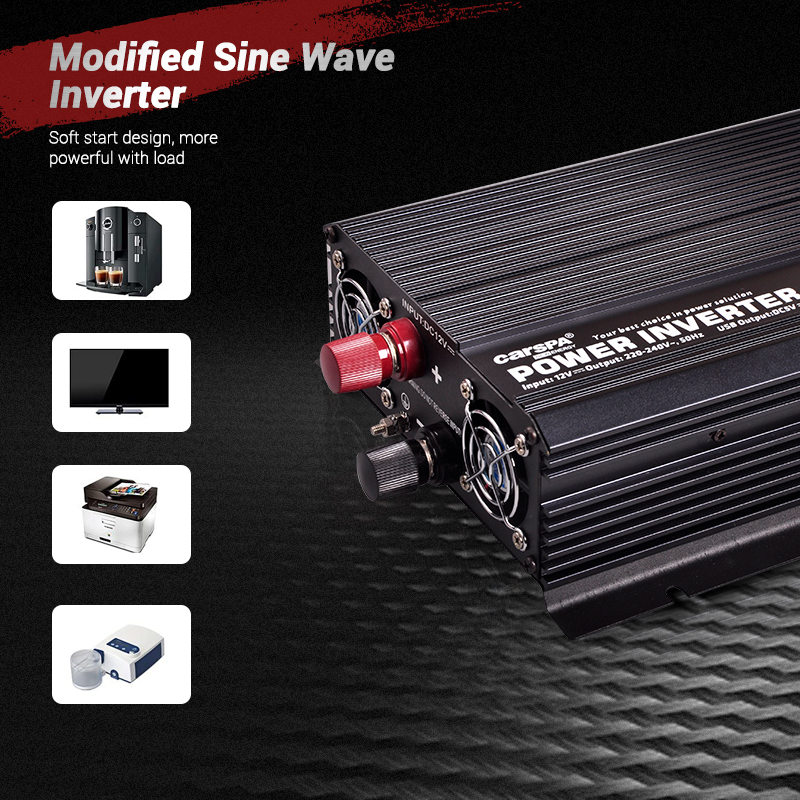What size of 1000W inverter is good for a 12 volt 200Ah battery?
The matching of inverter and battery is particularly important in many scenarios, especially when you plan to use a 12 volt 200Ah battery to power the inverter. How to choose a suitable 1000W inverter becomes a key issue. The size of the inverter not only determines how much power the device can provide, but also affects the battery life, operating efficiency, and overall stability of the system. This article will discuss the inverter size, battery matching, application scenarios, and purchase points in detail to help you make a wise choice.
What is the size of the inverter? How does the inverter size affect the matching of the battery and the inverter?
The "size" of the inverter does not only refer to its physical size, but mainly to its power output capacity. A 1000W inverter means that it can provide 1000 watts of power under continuous load. The selection of inverter power needs to match the capacity of the battery, otherwise it may result in a shortened battery life or the device cannot operate normally.
Inverter power types: continuous power and peak power
Inverter power is divided into two categories: continuous power and peak power. Continuous power refers to the power that the inverter can output stably for a long time, which is suitable for continuous power supply for household appliances, electronic products, etc. Peak power is the maximum power that the inverter can provide in a short period of time, usually used to cope with the instantaneous high power demand when the device starts.
For example, a 1000-watt power inverter has a continuous power of 1000 watts, while the peak power may reach 2000 watts or more, which means that it can cope with a sharp increase in power demand in a short period of time, such as the start-up of a refrigerator, air conditioner or power tool.
Matching of inverter power with 12V 200Ah battery
In order to understand the adaptability of the inverter, we first need to calculate the total energy that a 12V 200Ah battery can provide. This can be obtained through the following formula:
Battery capacity (watt-hour) = battery voltage (volts) × battery capacity (ampere-hour)
2400 watt-hours = 12 volts × 200 ampere-hours
This means that the total capacity of a 12-volt 200Ah battery is 2400Wh (watt-hours). If your inverter has a continuous output power of 1000W, the battery can theoretically power the device for 2.4 hours. The calculation is as follows:
Run time = battery capacity (watt-hour) / device power (watt) = 2400 watt-hours / 1000 watts = 2.4 hours
However, this is only an ideal calculation. The actual run time is usually affected by inverter efficiency, load changes, and battery health.
Is a 1000W inverter suitable for a 12-volt 200Ah battery?
For a 12-volt 200Ah battery, choosing a 1000W inverter is a relatively reasonable solution. It can provide power for a variety of household devices without over-consuming the battery, ensuring the battery life and system stability.
Types of devices supported
1000W inverters are suitable for powering a variety of household and outdoor devices, including:
Small refrigerators (100W to 200W)
TVs (100W to 150W)
Lighting equipment (20W to 50W)
Fans or portable power tools (less than 500W)
Laptops (150W to 300W)
Based on the power requirements of these devices, the battery runtime can be calculated. For example, if you use a 1000W power inverter to power a 200W small refrigerator, the battery can continue to power for:
Run time = 2400 watt-hours/200 watts = 12 hours
This means that your 12V 200Ah battery can theoretically provide power for a small refrigerator for up to 12 hours, meeting the needs of daily outdoor use or emergency power supply.
The effect of inverter efficiency on battery use
The efficiency of the inverter is another important factor. Generally speaking, the efficiency of the inverter is between 85% and 95%. The higher the efficiency, the less battery power is lost and the longer the running time.
If the efficiency of the inverter is 90%, the actual available power of the battery will be:
Actual available power = battery capacity (watt-hour) × inverter efficiency = 2400 watt-hour × 0.9 = 2160 watt-hour
This means that you can get 2160Wh of actual power. If you power a 200W small refrigerator, the actual running time will be:
Run time = 2160 watt-hour/200 watts = 10.8 hours
Therefore, choosing a high-efficiency inverter can not only extend the battery power supply time, but also improve the overall performance of the system.
Peak power and starting current requirements
Some devices require higher power when starting, which is called starting power. For example, a 200W refrigerator may require 300W or even higher power when starting. Therefore, the peak power of the inverter is also crucial.
A 1000W inverter can usually provide 2 or even 3 times the peak power, which is suitable for dealing with the instantaneous demand when the device starts. If the device requires higher starting power, choosing an inverter with higher peak power will ensure that the device can start normally.
How to choose the right inverter brand and model?
Choosing an efficient and reliable inverter brand and model can ensure the long-term stable operation of the system. There are many brands on the market that provide inverters with different powers and functions. Well-known brands such as CARSPA inverters are highly respected. CARSPA is a senior inverter manufacturer that focuses on providing efficient and stable power conversion equipment, which is widely used in outdoor power, RV and home emergency power supply systems.
Advantages of CARSPA inverters
CARSPA car inverters have the following key advantages:
High efficiency conversion rate: CARSPA inverters are usually more than 90% efficient, which can reduce power loss and extend battery life.
Safety protection function: CARSPA inverter is equipped with comprehensive safety protection functions, including overload protection, overheat protection, short circuit protection and low voltage alarm, ensuring that the battery and equipment are fully protected during operation.
Versatile application: CARSPA inverter is suitable for a variety of scenarios, such as outdoor activities, RV travel, home power emergency and power supply for small industrial equipment. It can provide stable power output both in harsh environments and in daily use.
How to choose a model according to needs?
When choosing an inverter, you should choose a suitable model according to load requirements, usage scenarios and battery capacity. For example, if you only need to power small home appliances and electronic devices, a 1000W RV inverter is usually sufficient. If your device has a large power demand or needs to power multiple devices at the same time, you can consider choosing a higher power inverter, such as 1500W or 2000W.
Additional functions of the inverter
In addition to basic power output and protection functions, many modern inverters are also equipped with smart displays that can monitor voltage, current and power output in real time to help users better manage batteries and loads. Some high-end models of CARSPA also support remote control and monitoring functions, which are particularly suitable for RV or remote power supply applications.
How to optimize the use of inverters and batteries?
In addition to choosing the right inverter, it is also crucial to use the inverter and battery combination reasonably. Through correct operation and maintenance, the service life of the system can be further extended and efficient operation can be ensured.
Avoid over-discharge
In order to protect the battery, it is very important to avoid over-discharge. Over-discharge will cause the capacity of the battery to drop permanently and shorten its service life. Inverters are usually equipped with low voltage protection. When the battery voltage drops to a certain threshold, the inverter will automatically shut down to prevent battery damage.
Regular maintenance of batteries and inverters
Keeping the battery and inverter clean and well ventilated can effectively prevent the equipment from overheating. Regularly check the battery power, the cooling system of the inverter and the wiring to ensure that there is no looseness or corrosion.
Reasonable arrangement of load use
In order to extend the battery life, it is recommended to arrange the load use reasonably according to actual needs to avoid unnecessary power waste. For example, you can use the inverter to supply power after the peak period of electricity consumption, or try to avoid running multiple high-power devices at the same time.
Conclusion
In general, the combination of 12V 200Ah battery and 1000 watt power inverter is very suitable for a variety of application scenarios, such as home backup power, outdoor activities, RV travel, and small industrial power supply. By choosing an efficient inverter brand such as CARSPA and properly matching the battery and inverter power, you can ensure the efficient and safe operation of the system. During use, reasonable management of battery power, avoidance of over-discharge, and regular maintenance can further extend the service life of the equipment and improve the overall performance of the system.






